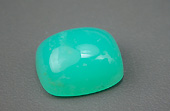
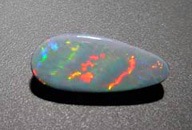
Due to their internal structure, a number of gem varieties show a surface or interior display of colors which are not part of the gems themselves, but rather created by the behavior of the light that enters them. This optical phenomenon, called iridescence, is familiar from everyday situations like the colored layer that oil or gasoline make on a puddle of water, or the rainbow effect we might see on the surface of a CD. Both diffraction and interference play a part in the effects we see.
In the case of color play in opals for example, the gem's ultrastructure based on uniformly packed spheres of cristobalite silica acts like a diffraction grating which breaks light into the various wavelengths of color. As they reflect from the various inner layers, the now, slightly out of phase waves combine and subtract by interference, and we see blocks of spectral colors. The size of the internal spheres determines the color: with mostly smaller spheres: we see blue, with mostly larger ones: we see red. Beyond a certain sphere size, as in common opal, light doesn't have to bend to travel through the openings, so no color play is seen.


In most of the other iridescent gems an ulrastructure of thin layers acts to create the color-making for diffraction and interference. One of the most highly valued gems of all time, pearl, gets its surface iridescence or "orient" from a subtle interference created as light travels through the thin layers of partially crystalline nacre. Mother of pearl and gem shell materials sometimes have intense color displays as well.
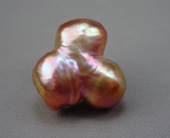
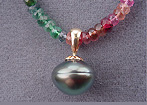
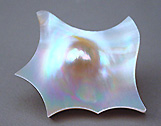
Labradorite is a form of feldspar that is noted for its iridescent optical phenomenon. In this gem in general, and in its more colorful variety, spectrolite, the iridescent effect is usually confined to a single direction, and is created by repeated thin laryer internal crystal twinning.
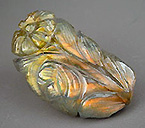
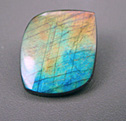
Some of the most beautiful less common gems, owe their striking colors to iridescence as well. Ammolite, a fossilized shell, which shows iridescent colors over a brown or dark grey shell matrix is rapidly gaining popularity as is fire agate, a form of iridescent botryoidal chalcedony.
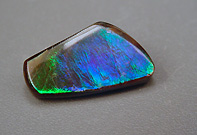
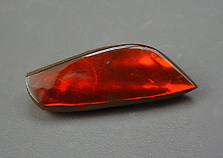
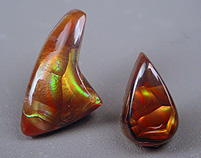
All else held constant, the stronger the phenomenon of iridescence the more valuable the gem. In opals, larger patches of color, greater saturation of color and more individual colors are more desirable than tiny points or single colors. In pearls, a thicker nacre coating creates a more visible and even display of orient which increases their value. Ammolites increase in value with the amount of blue and violet, in their displays, as red, green and gold are more common and the situation is very similar with fire agates.
The degree to which the phenomenon covers the entire surface is a strong value factor, with "dead" spots detracting substantially from value. Another factor is the degree of directionality of the phenomenon. All Labradorites and some fire agates and ammolites, for example have a single plane or a limited few angles at which strong colors show and at other angles this effect fades. As with any gem, body color, clarity, size and beauty of the fashioning are additional factors which influence price.